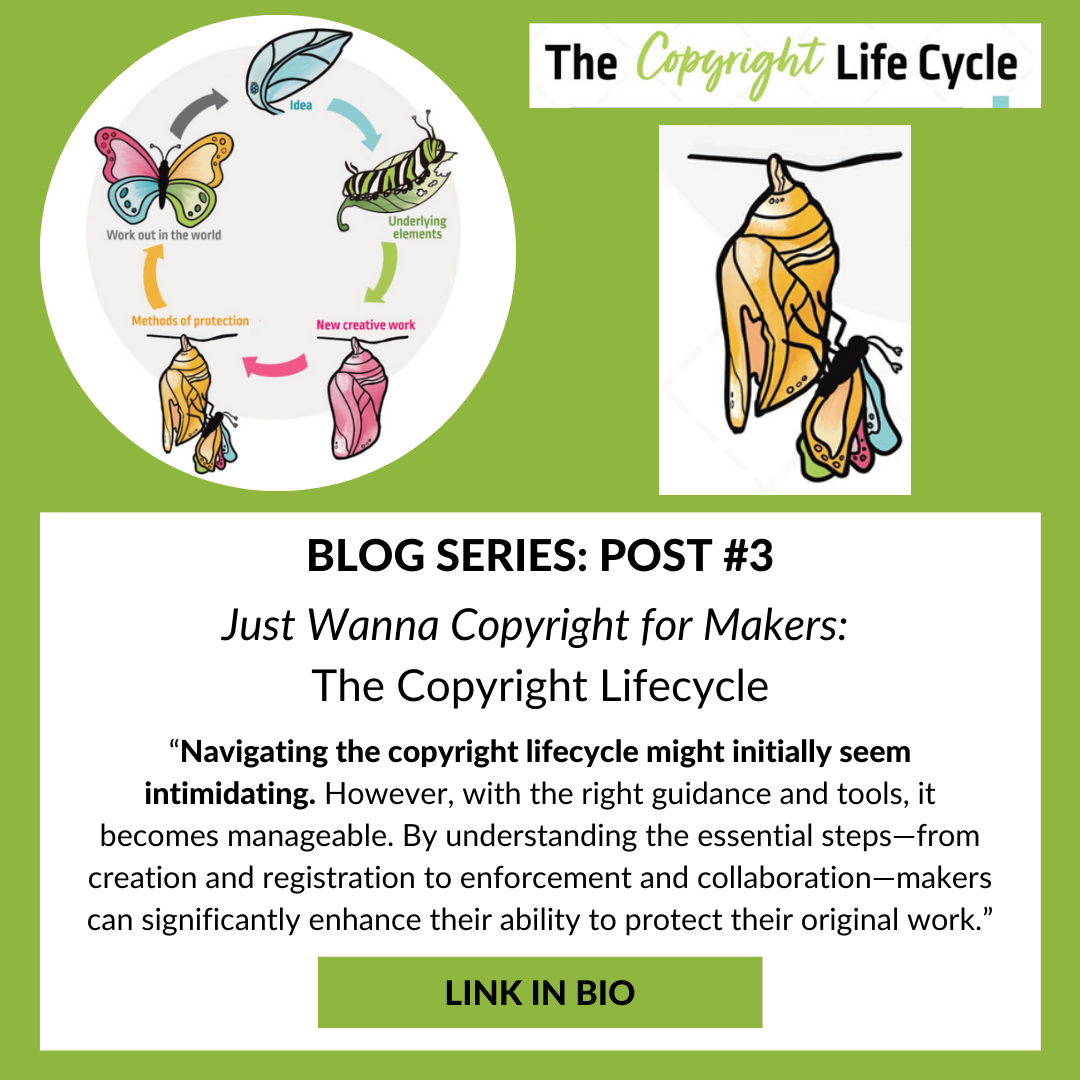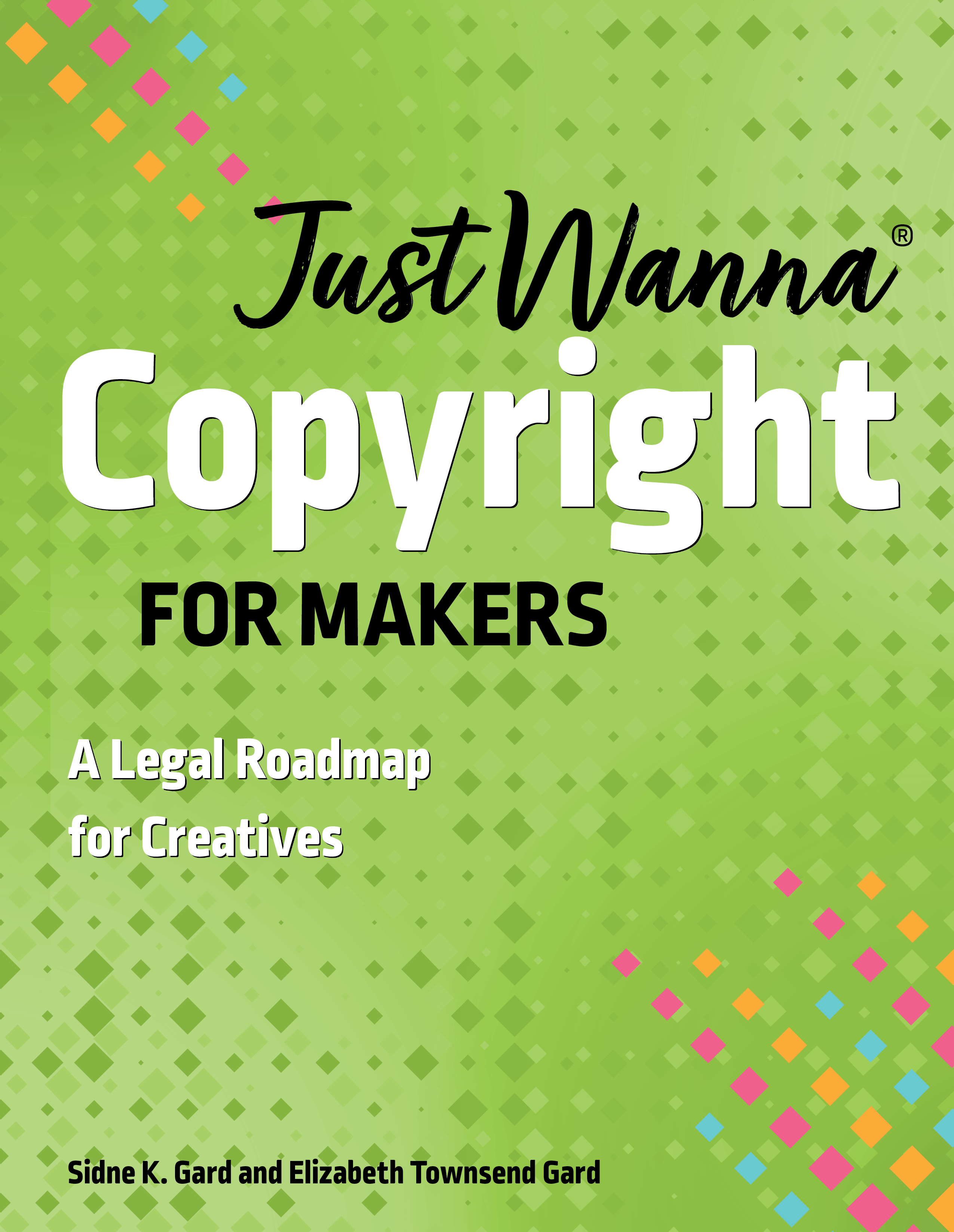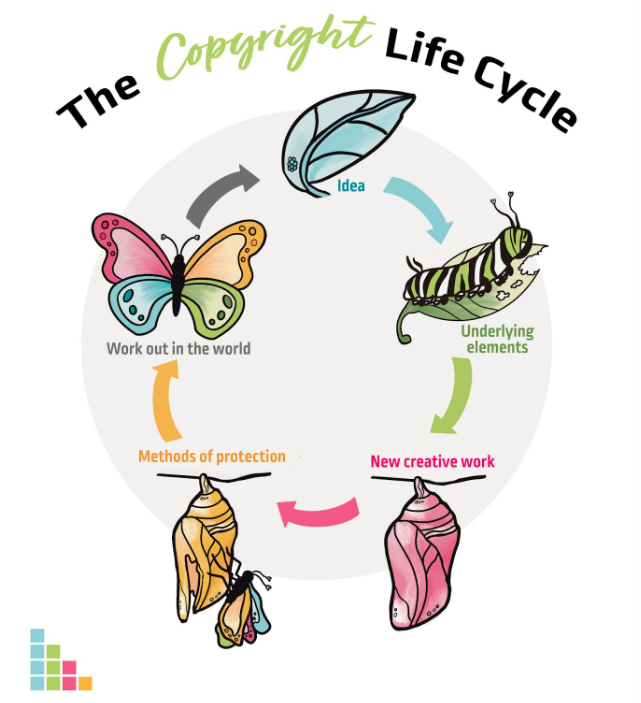Just Wanna Copyright for Makers: The Copyright Lifecycle
Posted by Elizabeth Townsend Gard & Sidne K. Gard on Jan 22nd 2025
Welcome to Post #3 of the blog series, Just Wanna Copyright for Makers, which highlights concepts from the recently released book and accompanying exhibit at the New England Quilt Museum. For more about the steps in the copyright lifecycle and other aspects of copyright, purchase a copy of the book!
Here is a brief excerpt from the book:
"We are all creators of new works, but we are also all borrowers of others’ works. There is a wonder in using old works, yesterday’s photos, books we grew up on, all kinds of works. We sometimes borrow legally by asking permission, or within a particular defense like fair use, library exceptions, or classroom uses. Sometimes we borrow without permission. But whatever we do, we are all creators and consumers of culture. We must recognize that whatever we create goes out into the world. That’s the metaphor of the butterfly."
Sid Gard, a co-author of Just Wanna Copyright for Makers came up with an idea: a copyrighted work is like the lifecycle of the butterfly. Use the Copyright Life Cycle Worksheet to document your creative process every step of the way. The Just Wanna Copyright for Makers includes the worksheet, and are also available for downloading.
STAGE 1: The Idea
Brainstorm and write/sketch down your ideas. As an artist, you think of an idea for a painting, a short story, or maybe a drawing. The idea grows. Until the idea is fixed in a tangible medium of expression (the painting is painted, or the sketch is started, the story is put down on paper), the idea remains just that: an idea. Copyright law in the United States protects works fixed in any medium. No term has begun until the idea is fixed. You may also want to keep track of where your ideas came from to better understand how your work sits within both an artistic and a legal context. The Life Cycle has a place for that too.
STAGE 2: Making the Creation
Let’s make it! You have identified the idea. You then build it—you take common elements like shapes (see Identifying Non-Protectable Elements, page 34), and/or things that are already in the public domain (see Identifying the Public Domain, page 65) like the original Winnie-the-Pooh, and you create something new. You might be using works that are under copyright, either through permissions (see Permission, page 61) or fair use (see Fair Use Basics, page 77) and you are obviously making your own things too. Let’s list them. There are a number of buckets to identify what source materials you are using for your creation.
STAGE 3: The Work I Made!
You select, arrange, and create new elements and in the process, like a butterfly, a copyrighted work emerges. On the form we’ve included a check box to mark whether your work meets the originality standard (see Originality Standard, page 29). You don’t have to meet the originality standard, you just won’t have a copyrightable work if you do not. That’s okay, you just can’t exclude others from using your work. You can indicate the type of work (see Types of Works, page 123). If you decide to register your work, you will have to decide whether it fits into the U.S. Copyright Office categories: literary, visual, performing, audiovisual, photographs, and sound recording. (See Registering Your Creative Work, page 121.) We’ve included a short place to include a description of the work, too!
STAGE 4: Protection
In this section of the form you can note how you may want to protect your work. We’ll be diving into the various ways you can opt to protect your work in Part III: Protecting, page 110.
STAGE 5: Out in the World
Once your work is out in the world, all kinds of things can happen to them—good, exciting, and sometimes bad or frustrating. Get ready! Your work is about to start its journey and fly to places you might never have imagined. And with it, new eggs/ideas are created. And the copyright life cycle begins again. Eventually, your work will enter the public domain, but that is a long time from now, unless you opt to share it sooner, which we’ll dive into in What is a Creative Commons License?, page 119.
The New England Quilt Exhibit
We have taken the lifecycle and provided concrete examples of the steps. We’ve even had artist Kit Montgomery felt a butterfly! Come by and see the show, which runs January 14-March 29.
Navigating the copyright lifecycle might initially seem intimidating. However, with the right guidance and tools, it becomes manageable. By understanding the essential steps—from creation and registration to enforcement and collaboration—makers can significantly enhance their ability to protect their original work. To gather more insights on these topics, consider reading Just Wanna Copyright for Makers. It is packed with valuable information designed for creators at any stage of their artistic journey.
Embrace your creativity, safeguard your passions, and engage in discussions around copyright in the maker community—every project matters.
...
Elizabeth Townsend Gard is the John E. Koerner Endowed Professor of Law at Tulane University Law School and an avid quilter since childhood. She holds a Ph.D. in Cultural History from UCLA and has been cited by the U.S. Supreme Court for her work on copyright. Elizabeth is the lead author of the series. Elizabeth focuses on the legal expertise of the book.
Sidne K. Gard is a Distinguished Scholar Scholarship student at the School of the Art Institute of Chicago and an Entertainment Editor at F Newsmagazine. Sidne focuses on translating legal concepts to artists and crafters. Sidne is the Managing Editor and Design Director for the Just Wanna Trademark for Makers series.
Elizabeth and Sidne started Just Wanna Quilt, which has also expanded to crafts and art. Listen to the podcast and learn more at justwannaquilt.com.










